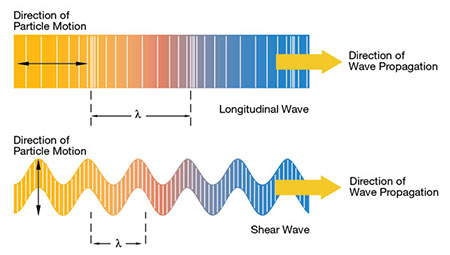2.3 声波传播
Sound energy used in flaw detection travels in different wave modes based on the direction of the wave and the corresponding motion of molecules in the test piece. The most commonly used modes are longitudinal waves, shear waves, and surface waves.
Longitudinal waves: In a longitudinal wave, particle motion in the medium is parallel to the direction of the wave front. Audible sound waves are longitudinal waves. Longitudinal waves travel the fastest of the wave modes commonly used in ultrasonic NDT, approximately 5900 meters per second (0.23 inches per microsecond) in steel. Longitudinal waves may convert to shear waves through refraction or reflection, as discussed in section 2.5 below.

Shear waves: In a shear wave, particle motion is perpendicular to wave direction. Shear waves have a slower velocity and shorter wavelength than longitudinal waves of the same frequency and are used for most angle beam testing in ultrasonic flaw detection. Typical shear wave velocity in steel is approximately 3250 meters per second (0.128 inch per microsecond). Shear waves can exist in solids only, not in liquids or gasses. They can convert to longitudinal waves through reflection or refraction at a boundary.
Surface waves: Surface waves, also known as Rayleigh waves, represent an oscillating motion that travels along the surface of a test piece to a depth of one wavelength. Velocity and wavelength are similar to shear waves. Ocean waves are an example of surface waves. Surface waves can be used to detect surface-breaking cracks in a test piece.
Several additional wave modes exist but are much less commonly used in ultrasonic flaw detection. These include Lamb waves and various other forms of plate waves and guided waves that are outside the scope of this tutorial.